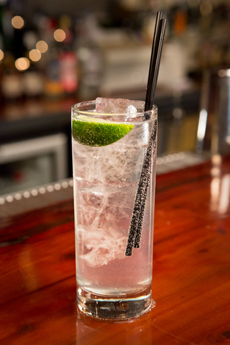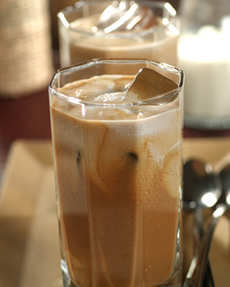|
…AND FOR DESSERT, RAVIOLI!
Yes, ravioli. Even better, ravioli you can make yourself with the help of a great pasta-maker to teach you how. It’s not just deliciously gratifying, but it’s a good workout too. Rolling fresh pasta dough until it’s as thin as a sheet of paper is not for the “where’s-the-remote?” in you.
New York City’s renowned Chelsea Market recently nabbed a new restaurant and shop: Giovanni Rana Pastificio & Cucina.
Rana is Italy’s leading fresh pasta company, and its artisan shop offers great dining, select Italian ingredients and designer kitchen accessories. Each pasta served at the restaurant, as well as those that can be purchased to cook at home, is house-made, fresh from scratch.
Lucky for us, Giovanni Rana is generous with his expertise and will share his secrets with eager learners. In our class, we learned how to make tiramisu ravioli for dessert.
|
|

Preparing chocolate ravioli. Photo courtesy Giovanni Rana. |
Pasta-making classes are held once a month and guide you through each step of making your own filled pasta. Individual “stations” are set up for each student, complete with all of the ingredients and tools needed. You begin by learning how to carefully blend the dough ingredients, then get ready to knead and roll—and roll and roll some more.
By the end of the session, you’ll have your own creation packed up for taking home, after which you enjoy a dinner made for you by Rana’s chefs, some wine and a take-away bag of products and recipes.
Although there may not be a Rana shop in your area, scout out a local cooking school or culinary program that’s nearby. It’s fun to do, it’s delicious to eat, and it’s made by you.
By the time your skills become second nature, you’ll be able to delight your family and friends with—yes—tiramisu ravioli as a sweet finale to dinner.
—Rowann Gilman
|

Preparation for tiramisu ravioli. Photo
courtesy Giovanni Rana. |
|
RECIPE: RANA’S TIRAMISU RAVIOLI
This recipe makes 14 to 16 ravioli, or about two servings. You can double the recipe, and freeze any excess for up to six months. Serve the ravioli with crème fraîche, mascarpone or ice cream.
Ingredients
For The Dough
100g #00 flour (fine flour for baking)
1 egg
Pinch of salt
10g instant espresso powder
Filling
50g ricotta
50g mascarpone
20g semi-sweet chocolate, chopped
20g instant espresso powder
10g marsala
1 tablespoon sugar
For The Dipping Sauce
50g fresh washed, hulled strawberries, dried and cut in halves
Optional: brown sugar
Optional: fresh mint leaves
To Finish
Canola oil
Confectioners sugar
|
|
Preparation
Make The Dough
1. PLACE the flour on a floured surface and make a well in the center. Break the egg into the well and mix it with a fork. Add the salt and instant espresso powder; blend with fingers until dough forms a rough shape.
2. BEGIN to knead and fold the dough over and over until it forms a smooth ball, about 8 to 10 minutes. Wrap the ball in plastic wrap and refrigerate 1 hour.
Make The Filling
1. COMBINE all of the filling ingredients in a medium mixing bowl, mixing with a wooden spoon until thoroughly blended.
Make The Dipping Sauce
1. PLACE the strawberries in the bowl of a food processor; blend until berries are puréed. If desired, add brown sugar and/or fresh mint to taste. Strain the mixture through a fine sieve; set aside.
Assemble The Ravioli
1. REMOVE dough from refrigerator. On a heavily floured surface, begin to roll and rotate the dough, turning it over after every few rolls. Continue until dough is perfectly even (smooth hands over dough to feel any difference in its thickness) and extremely thin.
2. FOLD the dough in half, then bring the top half upward. Starting about an inch from the halfway fold and left edge, place filling 1 teaspoonful at a time, slightly rounding each, on the bottom half of dough. Leave 1 inch between each mound of filling. When filling is used up, moisten the dough between each spoonful using a pastry brush and water. Be careful not to use too much water; use just enough for the top layer of dough to stick.
3. GENTLY LIFT the top half of dough and place it over the bottom half. Press between the mounds of filling where dough has been moistened, making sure both layers of dough stick together. Using a hand ravioli cutter, cut out the individual ravioli and place them on a floured surface, keeping them apart.
4. HEAT about 1 inch of canola oil in a heavy skillet until very hot. Fry the ravioli for about two to three minutes on each side until dough is firm. Remove from skillet and drain very well on paper towels or a brown paper bag. Let cool.
5. SERVE the ravioli sprinkled with confectioners sugar and a small bowl of the dipping sauce on the side.
MORE DESSERT RAVIOLI & OTHER PASTA
Butternut Squash & Maple Syrup Ravioli with Pears, Apples, Walnuts & Rum Raisin Ice Cream (recipe)
Peanut Butter & Jelly Ravioli With Cinnamon Ice Cream (recipe)
Other Sweet Pasta Recipes: Chocolate Fettuccine Mont Blanc, Dessert Lasagne, Songbirds’ Nests, Chocolate Spaghetti, Fettuccine Alfredo With Crème Anglaise, Fettuccine With Chocolate Sauce, Manicotti “Cannoli,” Orange Spaghetti, Pumpkin Ravioli With Mascarpone Sauce, More
|
|






